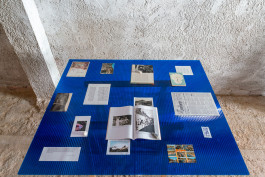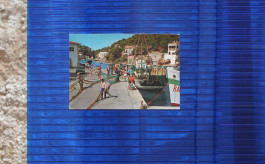
Villa Babel
Arantxa Boyero, Marijo Ribas, Florence de l’Olivier, Sergio Monje, Elisa Braem, Biel Llinàs
Exposición comisariada por Aina Pomar Cloquell
Babel Mallorca, 12-27 junio 2024, Cala Figuera.
En la exposición colectiva Villa Babel participo con una serie de piezas del proyecto "Créixer cap amunt, cap avall, avant i enrere en el temps" centrada en las narrativas ficcionadas alrededor de dos fenómenos muy vinculados a Mallorca: las cuevas calcáreas de explotación turística y los castillos neomedievales. El simulacro e hiperrealidad de un mundo imaginario se recrea tanto en el espacio geológico como en la arquitectura falseada para crear una oferta deseable al turista, ávido de experiencias simbólicas domesticadas. El territorio es entendido como un producto de consumo, creando un impacto tanto en el paisaje como en la construcción identitaria.
Cala Figuera no fue ajena a estos imaginarios. El popular Mond Bar, del que solo quedan escombros a pocos pasos de esta exposición, contaba con su propia decoración inspirada en las cuevas de la zona. Otro espacio de ocio, El Castillo, usó su arquitectura palaciega como atractivo en sus años de roller-disco, ahora un atractivo para su potencial venta.
Villa Babel
Arantxa Boyero, Marijo Ribas, Florence de l’Olivier, Sergio Monje, Elisa Braem, Biel Llinàs
Curated by Aina Pomar Cloquell
Babel Mallorca, 12-27 June 2024, Cala Figuera.
In the collective exhibition Villa Babel I participate with a series of pieces from the project "Growing up, down, forward, and backward in time" focused on the fictionalized narratives around two phenomena closely linked to Mallorca: the limestone caves of tourist exploitation and the neo-medieval castles. The simulacrum and hyperreality of an imaginary world is recreated both in the geological space and in the falsified architecture to create a desirable offer to the tourist, eager for domesticated symbolic experiences. The territory is understood as a consumer product, creating an impact on both the landscape and the construction of identity.
Cala Figuera was no stranger to these imaginaries. The popular Mond Bar, of which only rubble remains a few steps away from this exhibition, had its own decoration inspired by the caves in the area. Another leisure space, El Castillo, used its palatial architecture as an attraction in its roller-disco years, now an attraction for potential sale.
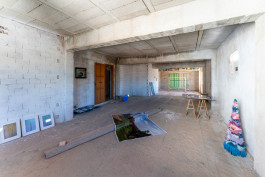
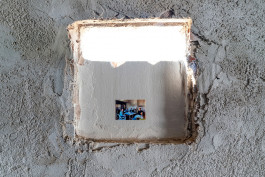
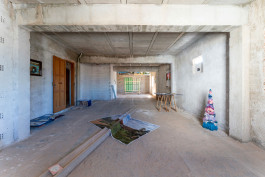
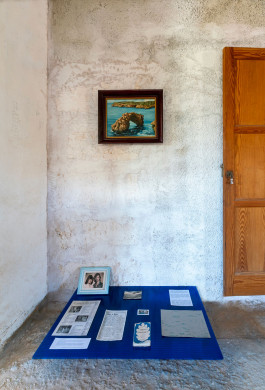
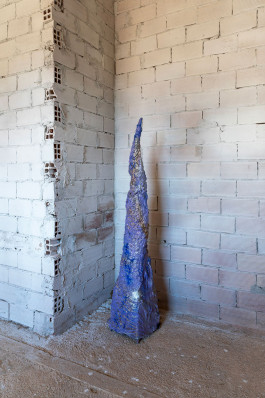
Estalagmita, 2021, de la serie "Créixer cap amunt, cap avall, avant i enrere en el temps"
Pieza escultórica de 160 x 30 cm. aprox. Aislante plástico, estructura metálica, acrílico y espray.
Stalagmite, 2021, from the series "Créixer cap amunt, cap avall, avant i enrere en el temps"
Sculptural piece measuring 160 x 30 cm. approx. Plastic insulation, metal structure, acrylic and spray.
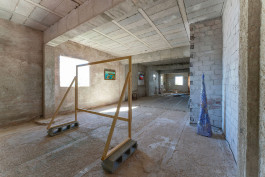
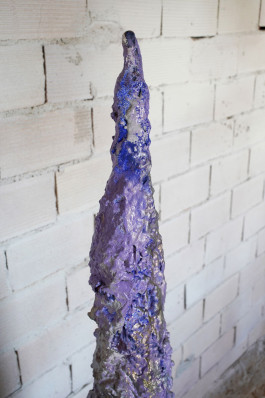
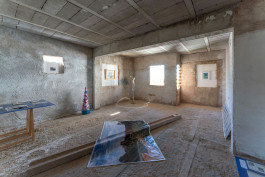
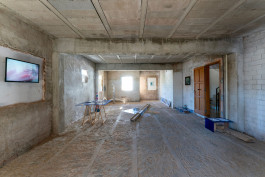
Castillo, rollerpark Cala Figuera, 2024, de la serie "Créixer cap amunt, cap avall, avant i enrere en el temps"
Fotografía impresa sobre hule, 94x190 cm.
Castle, Cala Figuera roller park, 2024, from the series "Créixer cap amunt, cap avall, avant i enrere en el temps"
Photograph printed on oilcloth, 94x190 cm.
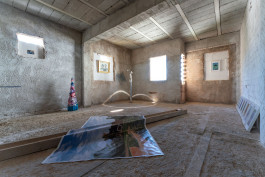
“Desde el tiempo pasado, aún muy bien conocido más allá de la isla, antiguo Disco de patinaje Castillo en Cala Figuera, actualmente a la venta. Situado en la calle principal de Santanyí. Una parcela de 3.964 m² con dos entradas y un edificio en forma de un castillo circular de 540 m² de superficie comercial y 140 m² de dependencias, en las cuales se encuentran dos viviendas para el personal, actualmente ocupadas. Precio:650.000 €”
Extracto modificado de un portal inmobiliario.
“From the past, still very well known beyond the island, former Castillo skating rink in Cala Figuera, currently for sale. Located on the main street of Santanyí. A plot of 3,964 m² with two entrances and a building in the form of a circular castle with 540 m² of commercial space and 140 m² of outbuildings, in which there are two staff apartments, currently occupied. Price: €650,000”
Modified extract from the real estate portal.
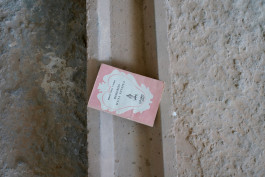
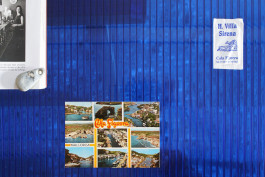
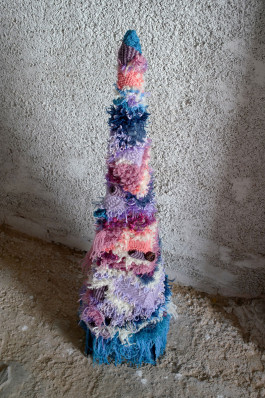
Estalagmita, 2024, de la serie Créixer cap amunt, cap avall, avant i enrere en el temps
Pieza escultórica de 105 x 30 cm. aprox. Estructura metálica y lana.
Stalagmite, 2024, from the series Créixer cap amunt, cap avall, avant i enrere en el temps
Sculptural piece measuring 105 x 30 cm. approx. Metal structure and wool.
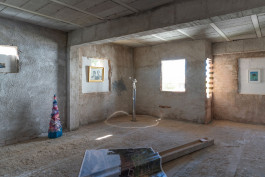
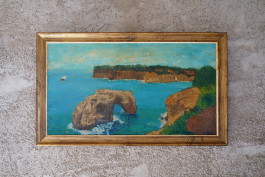
En su edición del 16 de agosto de 1958 el Quincenal de intereses locales Santanyí presentaba Cala Figuera como “poco más o menos una nueva Babel. Gente joven y vieja, rubia y morena. Diversidad de lenguas y de pareceres”. En los años cincuenta la Cala era un lugar inusual, todavía poco urbanizado, que aportaba tranquilidad a aquellos que la buscaban y diversión para los primeros turistas y veraneantes de la zona.
Algunas de las primeras fincas y hostales adoptaban el prefijo “Villa”, un término no autóctono pero que, probablemente por influencia italiana, ya hacía años que se utilizaba en la isla para dar un nombre diferenciado tanto a las viviendas para todo el año como a las de veraneo.
Bajo los términos Villa, como entidad arquitectónica, y Babel, para referirse a la coexistencia de aspectos de origen diverso, se construye el núcleo central de la exposición: el habitar.
La palabra habitar acciona el proceso de investigación del proyecto que progresivamente se fragmenta en tres bloques, permeables y entrelazados entre sí. La propuesta expositiva no solo integra las obras materiales de los artistas, sino también la capacidad colectiva para generar situaciones en forma de encuentros, conversaciones, lecturas y reflexiones fomentadas por estos bloques. Las obras, objetos y documentos que forman parte de la exposición se pueden leer como trampolines hacia estas situaciones.
Pero, ¿cuáles son los bloques de este habitar al cual nos referimos aquí? El tiempo y la imposibilidad de habitarlo es el componente más etéreo que atraviesa la totalidad del proyecto. Mediante citas de Barthes y Arnaux reflexionamos sobre la posteridad, y el pasado se invoca a través de referencias al pasado de Cala Figuera. El presente, intangible y huidizo, está en el centro de los trabajos de Elisa Braem y Florence de l’Olivier.
El segundo elemento, posiblemente por el hecho de ser más palpable, obtiene una mayor representación en el proyecto: el espacio. Habitar un espacio se puede referir a ocupar un lugar concreto, quizás una habitación propia, quizás un lugar compartido. Heidegger nos recuerda que no habitamos porque construimos, sino que construimos porque habitamos. La idea de espacio navega, a través de las obras de Biel Llinàs, Marijo Ribas, Arantxa Boyero y Sergio Monje, entre aquello natural y artificial, pasando por el paisaje real y el construido, negociando entre la inmediatez de este y sus representaciones.
A lo largo de la preparación de este proyecto, los artistas y la comisaría se han querido situar en el entorno de Babel, en la costa santanyiera y en Cala Figuera, dedicando especial atención en sus espacios de encuentro. Se han preguntado: cómo se habitan estos espacios concretos? Con esta premisa, el 20 de abril de 2024, se reunieron en el espacio expositivo para habitarlo.
Este encuentro desarrollado a través de paseos, conversaciones, intercambios y, esencialmente, la presencia física común apunta hacia el tercer componente del habitar, inherente a todos los otros: habitar un cuerpo. Durante las horas que duró el encuentro se creó Villa Babel, un receptáculo de objetos, obras, documentos y conversaciones alrededor de la cuestión de la habitar y que integra el entorno inmediato como detonante de estas reflexiones.
Gracias a los artistas, a Aline y Arnaud, a Margalida Escalas, Emi Sacchi, Marisé Cloquell, Pep Pomar, Francesca Suau Artigas, autora del libro Cala Figuera (1955-1965). Qui necessita un cinema quan està de vacances?
Texto comisarial de Aina Pomar Cloquel.
Fotografía de Aline Vilallonga.
In its edition of 16 August 1958, Quincenal de intereses locales Santanyí (the town’s local fortnightly magazine), presented Cala Figuera as "more or less like a new Babel. Young and old, blonde and brunette people. A diversity of languages and opinions". In the 1950s, the Cala was an unusual place, still not very urbanised, which provided peace and quiet for those who sought it and fun for the first tourists and holidaymakers in the area.
Some of the first fincas and hostels adopted the prefix "Villa", a non-native term but which, probably due to Italian influence, had already been used for years on the island to give a differentiated name to both year-round and holiday homes.
The terms Villa, as an architectural entity, and Babel, to refer to the coexistence of aspects of different origins, point to the exhibition’s key concept: habitar.
The word “habitar” (to inhabit or to dwell) activates the research process of this project, and can be progressively fragmented into three blocks, permeable and intertwined with each other. The exhibition approach integrates not only the artists material works, but also the collective capacity to generate situations in the form of encounters, conversations, readings and reflections fostered by these blocks. The works, objects and documents that are part of the exhibition can be read as springboards towards these situations.
But what are the blocks of this dwelling to which we refer here? Time and the impossibility of inhabiting it is the most ethereal component that runs through the whole project. Through quotations from Barthes and Arnaux we reflect on posterity, and the past is invoked through references to Cala Figuera’s past. The present, intangible and elusive, is at the core of the works of Elisa Braem and Florence de l'Olivier.
The second element, possibly because it is more palpable, is more widely represented in the project: space. To inhabit a space can refer to occupying a specific place, perhaps a room of one's own, perhaps a shared place. Heidegger reminds us that only if we are capable of dwelling, only then can we build. The idea of space navigates, through the works of Biel Llinàs, Marijo Ribas, Arantxa Boyero and Sergio Monje, between the natural and the artificial, passing through the real and the constructed landscape, negotiating between the immediacy of the latter and its representations.
Throughout the preparation of this project, the artists and the curator wanted to place themselves in the surroundings of Babel, on the Santanyi coast and in Cala Figuera, paying special attention to their places of encounter. They have asked themselves: how are these specific spaces inhabited? With this premise, on 20 April 2024, they gathered in the exhibition space to inhabit it.
This encounter, developed through walks, conversations, exchanges and, essentially, a common physical presence, points towards the third component of dwelling, inherent to all the others: inhabiting a body. During the hours of the meeting, Villa Babel was created, a receptacle of objects, works, documents and conversations around the question of dwelling, integrating the immediate environment as a catalyst for these reflections.
Thanks to the artists, Aline and Arnaud, Margalida Escalas, Emi Sacchi, Marisé Cloquell, Pep Pomar, Francesca Suau Artigues, author of the book Cala Figuera (1955-1965). Qui necessita un cinema quan està de vacances?
Curatorarial text by Aina Pomar Cloquel.
Photography by Aline Vilallonga.
